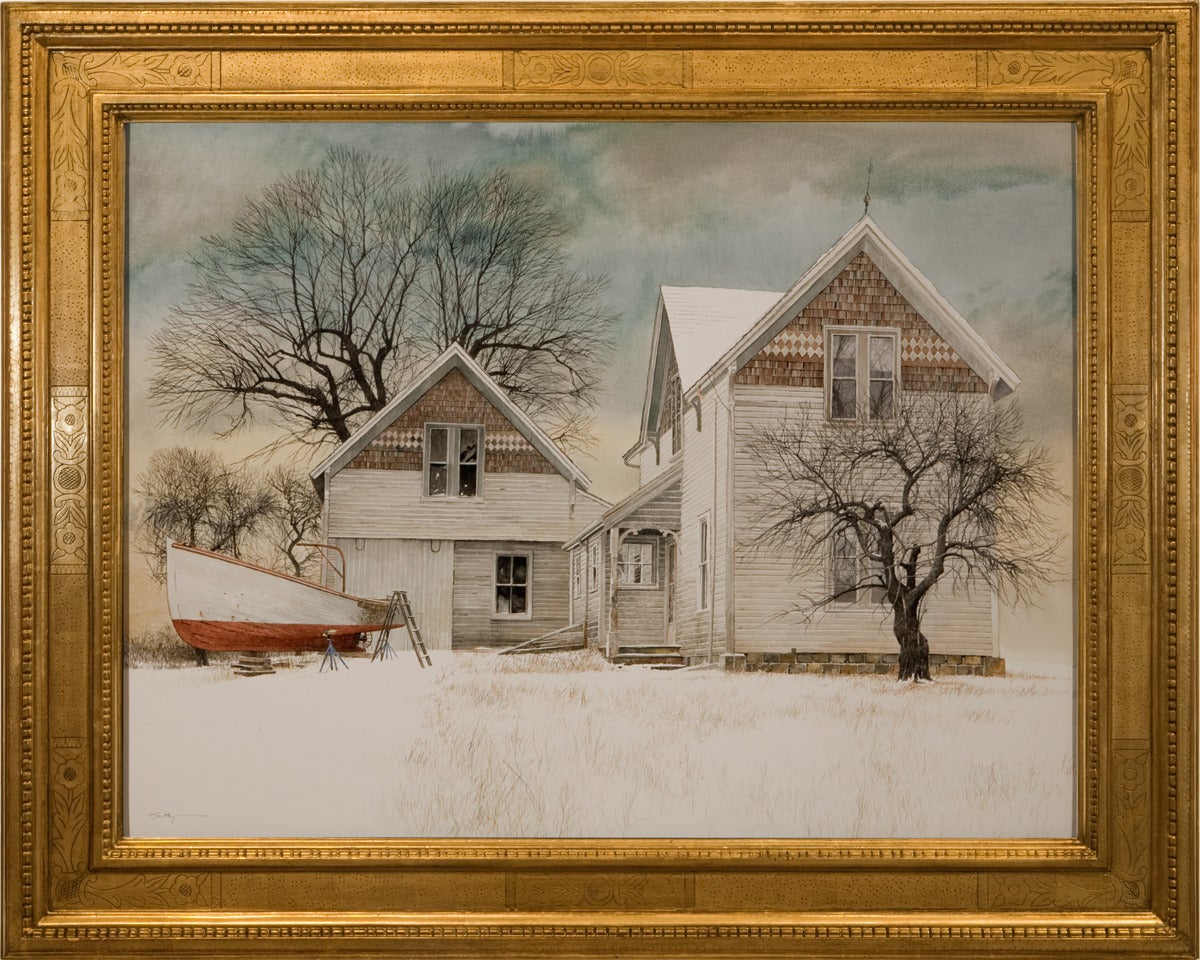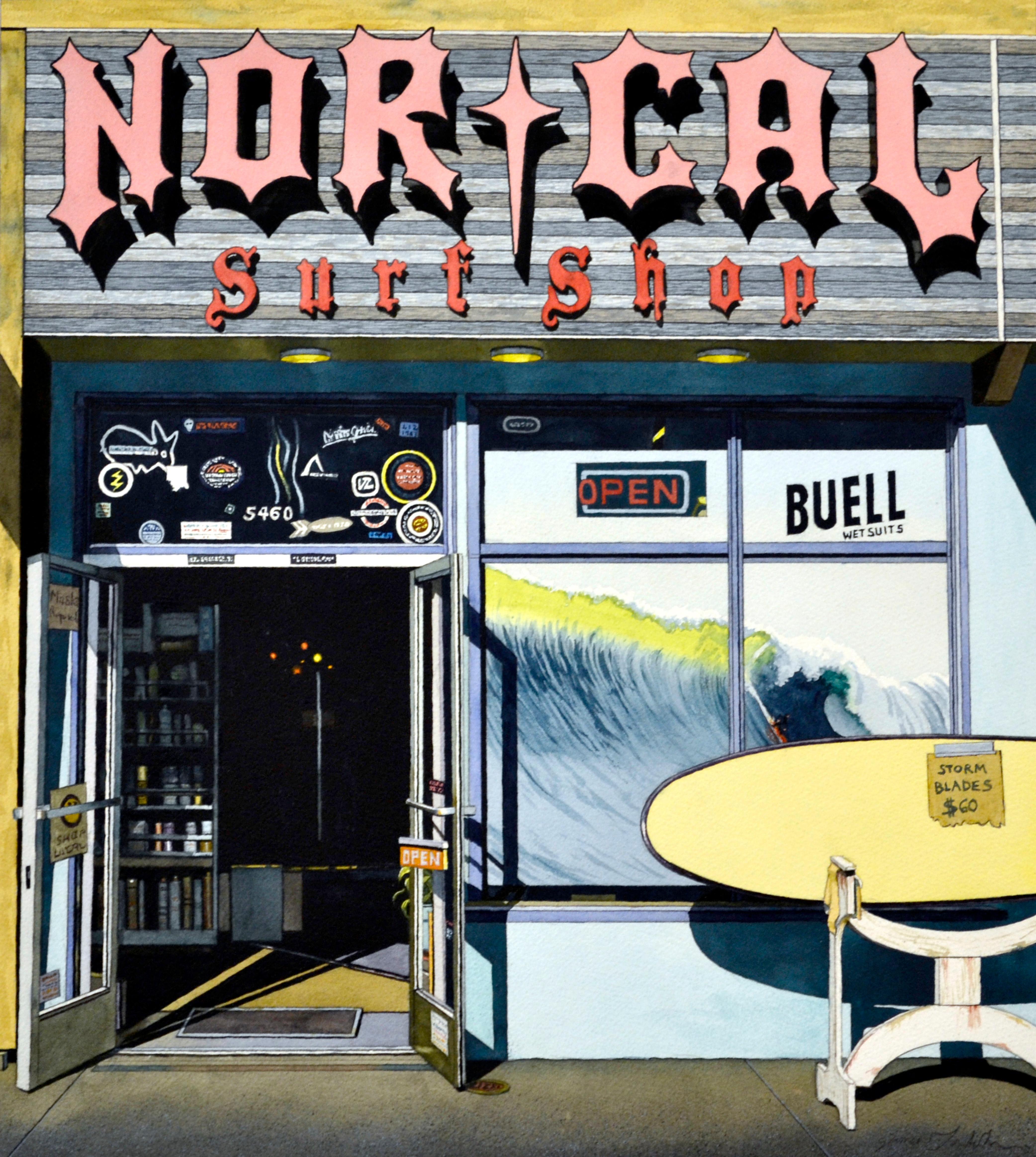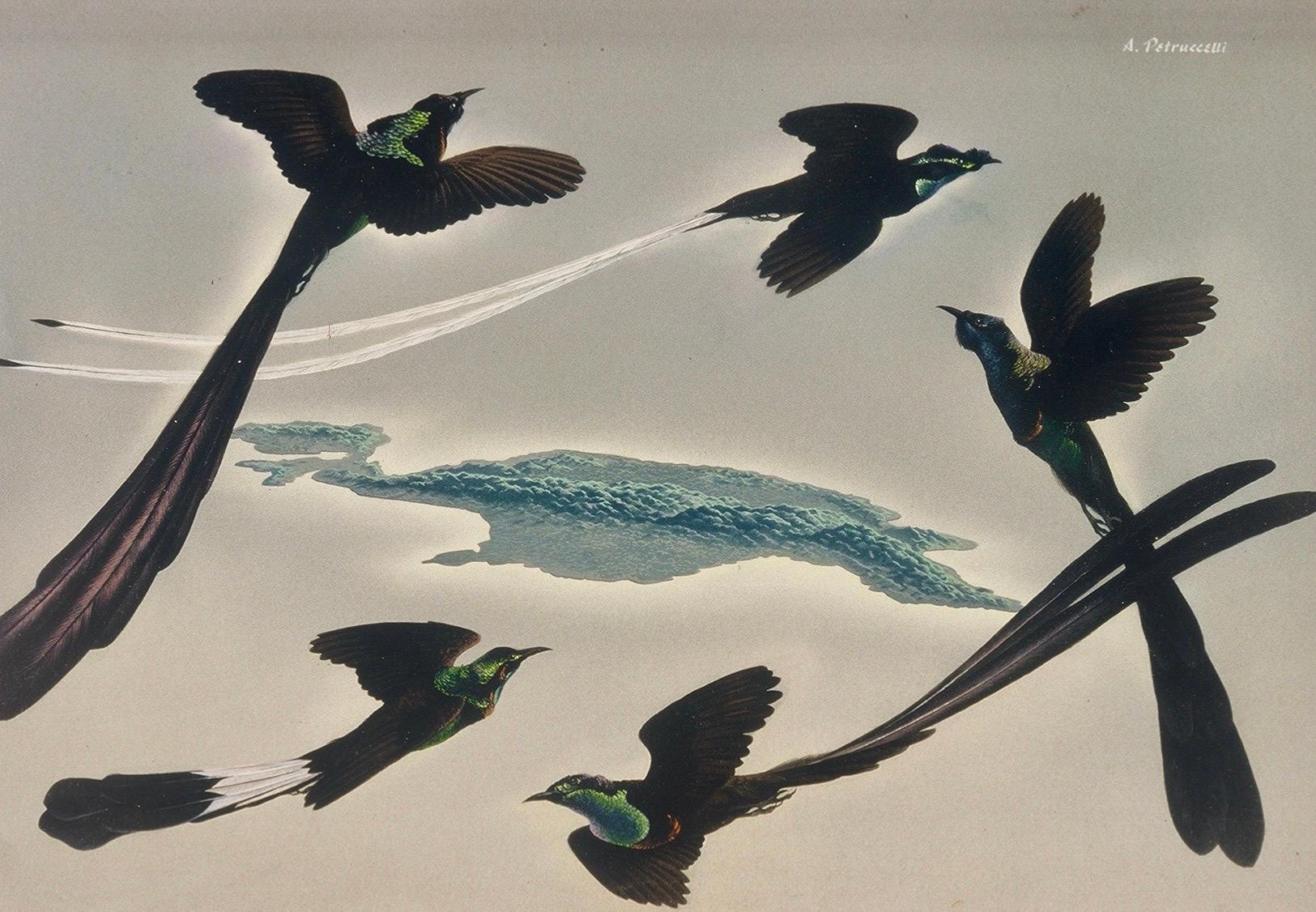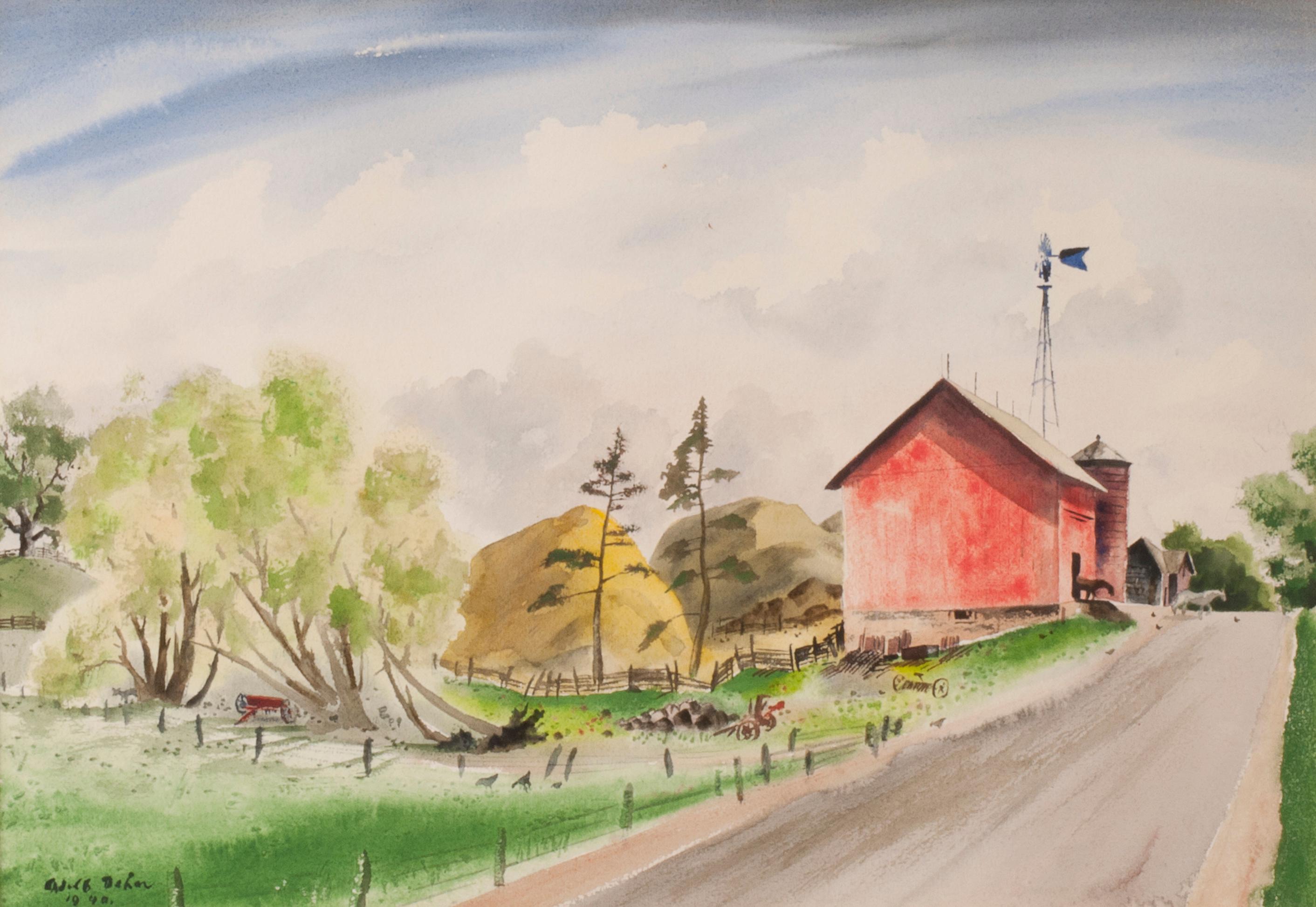Jill PoyerdStillness2018
2018
About the Item
Artist Comments
By limiting the painting to one color, a bit of distraction is removed, simplifying the scene and bringing a special serenity to the painting. Too much detail in one color could overwhelm, however, so each landscape is painted as a vignette, eliminating the sky and much of the foreground. The result is a very relaxing scene that goes right to the heart of what I wanted to communicate in the landscape.
About the Artist
Jill E Poyerd brings peaceful, contemplative moments to life on the canvas. She approaches the canvas with little preparation, instead allowing herself total freedom to create. Both her watercolor and oil painting works depict gorgeous scenes of nature with a style distinctly her own. Something as common as a tree appears soft and ethereal through Jill;s painterly style.
Stillness
Jill Poyerd
Watercolor painting on paper
Ready to frame
One-of-a-kind
Signed on front
2018
15 in. h x 24 in. w
0 lbs. 8 oz.
- Creator:
- Creation Year:2018
- Dimensions:Height: 24 in (60.96 cm)Width: 15 in (38.1 cm)Depth: 0.1 in (2.54 mm)
- Medium:
- Movement & Style:
- Period:
- Condition:Stillness. Jill Poyerd. Watercolor painting on paper. Ready to frame. One-of-a-kind. Signed on front.
- Gallery Location:San Francisco, CA
- Reference Number:
- ShippingRetrieving quote...Ships From: Leesburg, VA
- Return PolicyA return for this item may be initiated within 7 days of delivery.
- Point Lobos Succulents, Original PaintingBy Catherine McCargarLocated in San Francisco, CA
Artist Comments
Artist Catherine McCargar presents an intriguing close-up of succulents tenaciously adorning a dramatic cliff. The view overlooks the Pacific Ocean in Point Lobos Natural Reserve. "This park near Carmel, California, is among my most inspirational places to visit," shares Catherine. She joyfully gets lost in painting, adding detail after detail. The fluid colors allow the movement of pigments and the precision of brushwork.About the Artist
Impressionist Catherine McCargar expresses her deep admiration of nature through landscape paintings of Northern California...Category21st Century and Contemporary American Realist Landscape Drawings and Wa...
MaterialsWatercolor
- Final Light on the Mountain, Original PaintingBy Jill PoyerdLocated in San Francisco, CA
Artist Comments
I really enjoy combining realism with very impressionistic, almost abstract brushwork. The areas of this painting that are loosely interpreted are meant to e...Category21st Century and Contemporary American Realist Landscape Drawings and Wa...
MaterialsWatercolor
- Reaching OutBy Jill PoyerdLocated in San Francisco, CA
Artist Comments
By limiting the painting to one color, a bit of distraction is removed, simplifying the scene and bringing a special serenity to the painting. Too much detail...Category21st Century and Contemporary American Realist Landscape Drawings and Wa...
MaterialsWatercolor
- Near Strasburg, Original PaintingBy Judy MuddLocated in San Francisco, CA
Artist Comments
A barn quietly sits in the picturesque Pennsylvania countryside. The muted color palette evokes the serene tranquility inherent in the Amish homesteads of the r...Category21st Century and Contemporary Impressionist More Art
MaterialsWatercolor
- Eminent Domain, Original PaintingBy Dwight SmithLocated in San Francisco, CA
Artist Comments
An original landscape watercolor, painted in the realist tradition, portrays a small national park near Florida. The tide frequently overtakes the benches in th...Category21st Century and Contemporary Realist Landscape Drawings and Watercolors
MaterialsWatercolor
- A Moment to Ponder, Original PaintingBy Melissa GannonLocated in San Francisco, CA
Artist Comments
A wintry scene unfolds with bare trees and geese in flight along a riverbank. Tangled weeds create intricate patterns that harmonize with the freeform structure...Category21st Century and Contemporary Impressionist More Art
MaterialsWatercolor
- "Planning for Spring"By Peter SculthorpeLocated in Lambertville, NJJim’s of Lambertville is proud to offer this artwork. Watercolor. Signed lower left. Complemented by a hand carved and gilt frame. Peter Sculthorpe (b. 1948) Peter Sculthorpe wa...Category
21st Century and Contemporary American Realist Landscape Drawings and Wa...
MaterialsPaper, Watercolor
- Nor CalLocated in Burlingame, CA'Nor Cal, 2022' a highly collectable original watercolor by internationally acclaimed American Realist James Torlakson. The art is 20 x 18 inches and 29 x 27 inches professionally fr...Category
21st Century and Contemporary American Realist Still-life Drawings and W...
MaterialsArchival Paper, Watercolor
- Original Painting New Yorker Mag Cover proposal. Army Wedding American Scene WPABy Antonio PetruccelliLocated in New York, NYOriginal Painting New Yorker Mag Cover proposal. Army Wedding American Scene WPA Antonio Petruccelli (1907 – 1994) Army Wedding New Yorker cover proposal, c. 1939 11 1/2 X 8 inches ...Category
1930s American Realist Landscape Paintings
MaterialsBoard, Gouache
- Original Painting Life Mag Published 1955 Birds Animals Illustration Mid CenturyBy Antonio PetruccelliLocated in New York, NYOriginal Painting Life Mag Published 1953 Birds Animals Illustration Mid Century Antonio Petruccelli (1907 - 1994) The World We Live In Birds of Paradise Life Magazine Illustration ...Category
1950s American Realist Animal Paintings
MaterialsBoard, Gouache
- Flowers in the WindowBy W Stanley ProctorLocated in Tallahassee, FLRural American Home. Hope kept alive with the fresh flowers placed in the window for the world to see.Category
21st Century and Contemporary American Realist Landscape Drawings and Wa...
MaterialsWatercolor
- Horses Leaving the BarnBy Adolf DehnLocated in Fairlawn, OHHorses Leaving the Barn Watercolor on paper, 1940 Signed and dated lower left corner (see photo) Condition: Excellent Image: 14 1/2 x 21” Frame: 25” x 31” Provenance; Associated American Artists, New York (see photo of label) Mamdouha and Elmer Holmes Bobst Displayed in an original wormy chestnut frame with OP3 Acrylic. Most probably from the AAA Dehn watercolor exhibition of 1940. Vintage original framing chosen by the artist. Note: Elmer Holmes Bobst (1884–1978) was an American businessman and philanthropist who worked in the pharmaceutical industry. His wife, Mamdouha, was also well known philanthropist. Bobst was born in Lititz, Pennsylvania. He aspired to become a doctor, but instead, he taught himself pharmacology. After his wife Ethel composed his interview letter, he became manager and treasurer of the Hoffman-LaRoche Chemical Works by 1920. When Bobst retired from the company in 1944, he was one of the nation's highest paid corporate executives. In 1945 he took charge of the ailing William Warner Company (later Warner–Lambert) and he remained board chairman until his retirement. Bobst had close connections to President Dwight Eisenhower, but was also a close friend of President Richard Nixon. Note: In 1940, the year of this watercolor, Dehn and Elizabeth Timmerman visited Waterville, MN on their way to Colorado Sprint, Colorado where Dehn was to teach lithography and watercolor. This watercolor is obviously a view of the area around Waterville. Adolf Dehn, American Watercolorist and Printmaker, 1895-1968 Adolf Dehn was an artist who achieved extraordinary artistic heights, but in a very particular artistic sphere—not so much in oil painting as in watercolor and lithography. Long recognized as a master by serious print collectors, he is gradually gaining recognition as a notable and influential figure in the overall history of American art. In the 19th century, with the invention of the rotary press, which made possible enormous print runs, and the development of the popular, mass-market magazines, newspaper and magazine illustration developed into an artistic realm of its own, often surprisingly divorced from the world of museums and art exhibitions, and today remains surprisingly overlooked by most art historians. Dehn in many regards was an outgrowth of this world, although in an unusual way, since as a young man he produced most of his illustrative work not for popular magazines, such as The Saturday Evening Post, but rather for radical journals, such as The Masses or The Liberator, or artistic “little magazines” such as The Dial. This background established the foundation of his outlook, and led later to his unique and distinctive contribution to American graphic art. If there’s a distinctive quality to his work, it was his skill in introducing unusual tonal and textural effects into his work, particularly in printmaking but also in watercolor. Jackson Pollock seems to have been one of many notable artists who were influenced by his techniques. Early Years, 1895-1922 For an artist largely remembered for scenes of Vienna and Paris, Adolf Dehn’s background was a surprising one. Born in Waterville, Minnesota, on November 22, 1895, Dehn was the descendent of farmers who had emigrated from Germany and homesteaded in the region, initially in a one-room log cabin with a dirt floor. Adolf’s father, Arthur Clark Dehn, was a hunter and trapper who took pride that he had no boss but himself, and who had little use for art. Indeed, during Adolf’s boyhood the walls of his bedroom and the space under his bed were filled with the pelts of mink, muskrats and skunks that his father had killed, skinned and stretched on drying boards. It was Adolf’s mother, Emilie Haas Dehn, a faithful member of the German Lutheran Evangelical Church, who encouraged his interest in art, which became apparent early in childhood. Both parents were ardent socialists, and supporters of Eugene Debs. In many ways Dehn’s later artistic achievement was clearly a reaction against the grinding rural poverty of his childhood. After graduating from high school in 1914 at the age of 19—an age not unusual in farming communities at the time, where school attendance was often irregular—Dehn attended the Minneapolis School of Art from 1914 to 1917, whose character followed strongly reflected that of its director, Munich-trained Robert Kohler, an artistic conservative but a social radical. There Dehn joined a group of students who went on to nationally significant careers, including Wanda Gag (later author of best-selling children’s books); John Flanagan (a sculptor notable for his use of direct carving) Harry Gottlieb (a notable social realist and member of the Woodstock Art Colony), Elizabeth Olds (a printmaker and administrator for the WPA), Arnold Blanch (landscape, still-life and figure painter, and member of the Woodstock group), Lucille Lunquist, later Lucille Blanch (also a gifted painter and founder of the Woodstock art colony), and Johan Egilrud (who stayed in Minneapolis and became a journalist and poet). Adolf became particularly close to Wanda Gag (1893-1946), with whom he established an intense but platonic relationship. Two years older than he, Gag was the daughter of a Bohemian artist and decorator, Anton Gag, who had died in 1908. After her husband died, Wanda’s mother, Lizzi Gag, became a helpless invalid, so Wanda was entrusted with the task of raising and financially supporting her six younger siblings. This endowed her with toughness and an independent streak, but nonetheless, when she met Dehn, Wanda was Victorian and conventional in her artistic taste and social values. Dehn was more socially radical, and introduced her to radical ideas about politics and free love, as well as to socialist publications such as The Masses and The Appeal to Reason. Never very interested in oil painting, in Minneapolis Dehn focused on caricature and illustration--often of a humorous or politically radical character. In 1917 both Dehn and Wanda won scholarships to attend the Art Students League, and consequently, in the fall of that year both moved to New York. Dehn’s art education, however, ended in the summer of 1918, shortly after the United States entered World War I, when he was drafted to serve in the U. S. Army. Unwilling to fight, he applied for status as a conscientious objector, but was first imprisoned, then segregated in semi-imprisonment with other Pacifists, until the war ended. The abuse he suffered at this time may well explain his later withdrawal from taking political stands or making art of an overtly political nature. After his release from the army, Dehn returned to New York where he fell under the spell of the radical cartoonist Boardman Robinson and produced his first lithographs. He also finally consummated his sexual relationship with Wanda Gag. The Years in Europe: 1922-1929 In September of 1921, however, he abruptly departed for Europe, arriving in Paris and then moving on to Vienna. There in the winter of 1922 he fell in love with a Russian dancer, Mura Zipperovitch, ending his seven-year relationship with Wanda Gag. He and Mura were married in 1926. It was also in Vienna that he produced his first notable artistic work. Influenced by European artists such as Jules Pascin and Georg Grosz, Dehn began producing drawings of people in cafes, streets, and parks, which while mostly executed in his studio, were based on spontaneous life studies and have an expressive, sometimes almost childishly wandering quality of line. The mixture of sophistication and naiveté in these drawings was new to American audiences, as was the raciness of their subject matter, which often featured pleasure-seekers, prostitutes or scenes of sexual dalliance, presented with a strong element of caricature. Some of these drawings contain an element of social criticism, reminiscent of that found in the work of George Grosz, although Dehn’s work tended to focus on humorous commentary rather than savagely attacking his subjects or making a partisan political statement. Many Americans, including some who had originally been supporters of Dehn such as Boardman Robinson, were shocked by these European drawings, although George Grocz (who became a friend of the artist in this period) admired them, and recognized that Dehn could also bring a new vision to America subject matter. As he told Dehn: “You will do things in America which haven’t been done, which need to be done, which only you can do—as far at least as I know America.” A key factor in Dehn’s artistic evolution at this time was his association with Scofield Thayer...Category
1940s American Realist Landscape Drawings and Watercolors
MaterialsWatercolor




